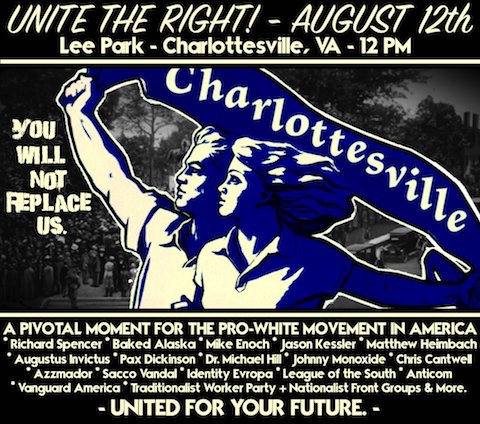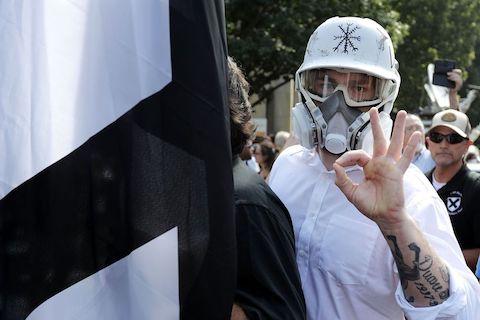Hundreds of protesters descended upon Charlottesville, Virginia, on Saturday for a “Unite the Right” rally: a belated coming-out party for an emboldened white nationalist movement in the United States.
The rally was dispersed by police minutes after its scheduled start at noon, after clashes between rallygoers and counter-protesters, and after a torchlit pre-rally march Friday night descended into violence. But activity is ongoing, with some rallygoers engaging in a march instead.
It was perhaps a predictable culmination to the event — which has been a prime example of the difficulty of disentangling defenses of “free speech” from efforts to prevent violence, and the fine line between the self-described alt-right movement and more widely recognized forms of white nationalism.
Self-described “pro-white” activist Jason Kessler organized the rally to protest the planned removal of a statue of confederate general Robert E. Lee from a park in Charlottesville. Kessler is affiliated with the alt-right movement that uses internet trolling tactics to argue against diversity and “identity politics” — part of a broader cultural backlash that helped elect Donald Trump.
But the rally quickly attracted other more traditional groups of white nationalists, neo-Nazis, and the Ku Klux Klan.
The involvement of hate groups and the threat of violence led the city of Charlottesville to attempt to marginalize the rally for “hate speech,” but the American Civil Liberties Union (ACLU) defended the demonstrators’ rights. The combination of rallygoers spoiling for a fight, and counter-protestors determined to convey that the rallygoers’ ideology was not welcome in America, allowed the violence to overshadow the speech — and eventually prevent the rally from going forward as planned.
Plans to remove a Confederate statue have made Charlottesville a hot spot for right-wing activism
Charlottesville, like many cities in the South, still has public spaces and monuments celebrating heroes of the Confederacy — many of which weren’t erected until the 20th century, as the civil rights movement began to pick up steam and Jim Crow laws started to come under attack.
In the wake of the 2015 massacre of several worshipers at Emmanuel AME Church in Charleston by a white supremacist, there’s been a renewed push to remove some of these Confederate monuments and rename streets and squares honoring the Confederacy. But where those campaigns have succeeded, there’s often been a backlash from conservatives concerned about attempts to erase history, Southerners who consider the Confederacy part of their “heritage,” and outright white nationalists.
In Charlottesville, advocates targeted a statue of Robert E. Lee in a park called Lee Square — City Council members pointed out that Lee had no connection to Charlottesville, implying that commemorating him was just an indirect way to celebrate the Confederacy, while a high-school student collected 600 signatures on a Change.org petition to rename the statue. (A counter-petition collected 2,000 signatures.)
In February, the city council voted to sell the statue and rename the park Emancipation Park. (The statue is still in place.)
The decision made the city a target for right-wing activism and shows of strength — and for activists keen to stand up to them and demonstrate that such ideas weren’t welcome. The Ku Klux Klan held a rally in Charlottesville in July, which was dwarfed by a massive counter-protest.
Meanwhile, Charlottesville resident Jason Kessler — a pro-white activist and a member of the Proud Boys, a loose collective of pro-Trump alt-rightists — put together the Unite the Right rally for Saturday, to be held at what event posters still call Lee Park. Speakers include some of the alt-right personalities who have flirted most openly with white nationalism, including Baked Alaska, an internet provocateur who was once the tour manager for fellow internet provocateur Milo Yiannopoulos, as well as self-identified white nationalists like Richard Spencer.
Political researcher Spencer Sunshine of the firm Political Research Associates told the Guardian’s Jason Wilson that while the rally was originally intended to attract a broad coalition of right-wing groups, it had become “increasingly Nazified” — with some primarily anti-government “patriot” groups refusing to sign on, and explicitly fascist groups like the National Socialist Movement getting on board instead.
And many supporters and attendees of the rally certainly had no problem using Nazi tropes to promote it, as this “fan art” poster shows:

According to the Charlottesville police affidavit put out before the rally, planned attendees included the Klan; the militia movement (a right-wing movement that gained traction in the 1990s, whose members include the activists who took over a federal nature reserve in early 2016); the “3%”, a right-wing anti-government movement; the Alt-Knights, an alt-right “fight club”; and others.
The Nazification of the alt-right
The arc of the Unite the Right rally — from an ostensible attempt to bring a broad coalition of conservative groups together to protest the controversial removal of a statue, to a “Nazified” rally for “the pro-white movement in America” — mirrors what’s been happening to the alt-right as a whole. The movement’s leaders have become increasingly willing to dabble in white-nationalist rhetoric and tropes, while attempting to avoid direct accusations of being themselves white nationalists.
The rise of the alt-right is one face of a broader backlash against “identity politics” and “political correctness,” which have left some white Americans feeling that they’re losing ground to nonwhites — or that America is losing its identity — and that political, economic, and media elites are either uninterested in defending their heritage or actively trying to eradicate it.
Among some younger, more internet-savvy people, hatred of “political correctness” has paired neatly with online troll culture, in which pushing boundaries and offending people is seen as harmless at worst and a show of cleverness at best.
In 2015 and 2016, the alt-right was an inescapable online presence, with some of its members crediting the movement’s “meme magic” with the unexpected popularity of Donald Trump in the Republican presidential primary and, later, the general election. With Trump’s election, some of its leaders have become more seriously engaged in politics, via pro-Trump organizations like the Proud Boys and the Alt-Knights.
Like Trump himself, alt-right leaders didn’t start out by explicitly aligning themselves with the sort of right-wing groups and movements that almost everyone in 2017 America is willing to agree are racist — like the Nazis or the Ku Klux Klan. But racist rhetoric has become a hallmark of the movement, from the use of “cuck” to deride anti-alt-right conservatives to Twitter harassment of Jewish journalists by photoshopping them into images of Nazi gas chambers.
That crosses the line into ideologies that most Americans agree are taboo. People may believe that Donald Trump supporters aren’t necessarily racists, but they are willing to agree that members of the Klan and Nazis are racists. Indeed, it’s a contrast with those groups that allows some people to draw the line between “real racism” and liberals “crying wolf” about racism. (This is true outside the alt-right as well — just look at pro-Trump commentator Jeffrey Lord, fired by CNN this week after tweeting “Sieg heil!” in what he claims was a joke.)
Many public figures and politicians on the left, center, and center-right have argued that the alt-right is defined by these actions — among many on the left, the term “alt-right” itself is an unacceptable euphemism that legitimizes an ideology that would be considered unacceptable if it were simply called white nationalism. Progressive writer Lindy West wrote in 2016 that the term “alt-right” was “an attempt to rebrand warmed-over Reconstruction-era white supremacy as a cool, new (and harmless!) internet fad.”
Instead of responding by deliberately distancing themselves from white nationalism, though, leaders of the alt-right have deliberately blurred the distinction. They’ve adopted memes and hand gestures (like the “okay” symbol) as an inside joke, because people outside the movement have mistaken them for white nationalist symbols. The attitude tends to be that if “the left” is going to see them as Nazis, they might as well encourage that conception.
But there are plenty of people whose Naziism isn’t ironic at all. And at an event like the Unite the Right rally, it’s impossible to tell the difference between someone who’s wearing a swastika pin or giving a Nazi salute “ironically” and someone who’s doing it in earnest. The people who claim they’re doing it “ironically” don’t appear to have any problem with that confusion.
The line between “protected speech” and violent street fighting is getting very blurry
As the movement behind the Unite the Right rally has become so closely intertwined with groups universally condemned as racist, the response to the rally has started to treat it as inherently illegitimate — as an attack on the rights of people of color, LGBTQ Americans, non-Christians, and immigrants to live and worship safely in the United States.
AirBnb shut down accounts of users who were seeking accommodations in Charlottesville for the rally, citing its “Community Commitment”: “those who are members of the Airbnb community accept people regardless of their race, religion, national origin, ethnicity, disability, sex, gender identity, sexual orientation, or age."
And local governments have taken the initiative to shut down right-wing demonstrations before they happen — forcing them into the tricky position of deciding the line between protected free speech activity and physical violence waiting to happen.
In Portland in June, the city government attempted to revoke a permit for a pro-Trump “free speech” rally, but didn’t succeed — then dispersed the rally and a counter-protest when they descended into violence.
In Charlottesville, the city government attempted to move the Unite the Right rally out of downtown; the ACLU helped defend the rally, and a judge’s injunction Friday night allowed the original plan to remain in place. (Virginia governor Terry McAuliffe, meanwhile, urged both would-be rallygoers and would-be counter-protesters to stay away from downtown Charlottesville Saturday.)
The problem is that while the law sees a clear distinction between speech and action when it comes to violence — a peaceful Nazi rally is protected by the First Amendment — many of the people attending do not.
The recent right-wing resurgence has fed a rise in an American “antifa” (short for “anti-fascist”) movement, dedicated to violent resistance of ideologies that it sees as inherently violent (or, in simpler terms, dedicated to punching Nazis). While the counter-protesters to Saturday’s Unite the Right rally planned peaceful resistance, some were prepared for self-defense; local activist Emily Gorecenski told the Guardian that she was carrying a gun because “The second amendment is one of the few civil rights I have left as a trans woman.”
And many rally participants, for their part, were more than willing to beat up counter-protesters — as was demonstrated during a related march Friday night on the campus of the University of Virginia, which devolved into a brawl when marchers assaulted counter-protesters around a statue of Thomas Jefferson.
After stepping in somewhat belatedly on Friday, police officers took an aggressive stand Saturday to prevent the rally from going forward as planned. Both the city of Charlottesville and the state of Virginia declared states of emergency Saturday, minutes before the scheduled start time of the rally (but after clashes had already begun). Shortly before noon, police assembled at the rally site and declared the assembly “unlawful” before the rally actually began, then moved immediately to disperse the crowd.
But it’s too late to keep the Unite the Right rally from becoming violent; to some, its concept was inherently violent, and few appear invested in stopping physical violence from erupting in its wake.


Spread the word